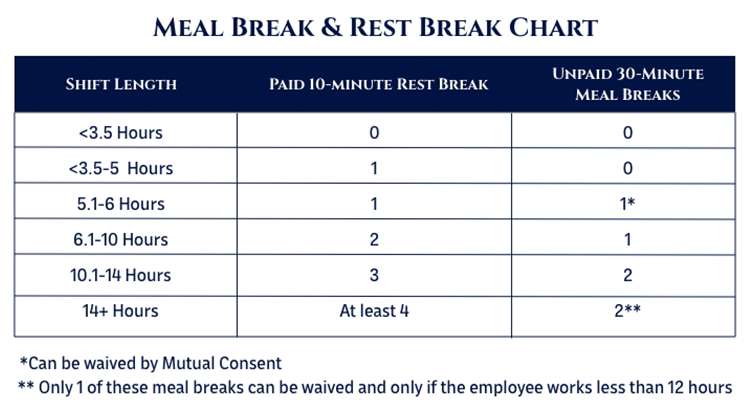California law protects the right of hourly employees to receive meal breaks and rest breaks each workday. The number of meal breaks and rest breaks in each shift depends on the length of the employee’s shift. The following chart provides some guidance:

Meal Breaks
California employers are required to provide hourly employees with meal breaks as explained by the California Department of Industrial Relations. As an hourly employee in California, you are entitled to a 30-minute break when you work more than five hours in a shift. This meal break is unpaid.
During your meal break, you should not be required to perform any work duties and you should be allowed to leave the workplace premises. These meal breaks should occur within the first five hours of your workday. You are given the right to waive it if you wish to but only when your shift does not exceed six hours. If your shift exceeds 10 hours, then you must be provided with a second meal break. It is your employer’s responsibility to ensure that your meal breaks are provided to you as required by law.
Employers are responsible for maintaining accurate time records for their employees. If your time records show that you did not receive a legal meal break (i.e., you received no meal break, a late meal break, or a short meal break), then the Court will presume that your employer committed a meal break violation, and your employer must prove otherwise. See Donohue v. AMN Services, LLC, 11 Cal.5th 58 (2021).
Common Meal Break Violations
Companies across California often fail to provide legally compliant meal breaks to their hourly employees in several different ways. Some examples are as follows:
- Employer requires employees to perform such a volume of work in a time-limited shift that the employer is impeding or discouraging employees from taking legally compliant meal breaks;
- Employer forces employees to quickly eat at their workstation, job post, or out in the field without clocking-out;
- Employer forces employees to clock-out for a supposed meal break before the end of the fifth hour of their shift, and to continue working (off-the-clock) past the end of the fifth hour of their shift;
- Employer requires employees to remain on-duty and/or remain responsive via a cell phone or walkie-talkie during their supposed meal break;
- Employer calls employees back to work in the middle of their meal breaks;
- Employer rounds employees’ meal break time-punches in a fashion that infringes on the employee’s meal breaks.
Meal Break Premium Pay
If an employer does not provide an employee a meal break as required by California law, the employer shall pay the employee one (1) hour of pay at the employee’s regular rate of compensation for each workday that the meal break was not provided.
Rest Breaks
California employers are required to provide hourly employees with meal breaks as explained by the California Department of Industrial Relations. As an hourly employee in California, you are entitled to one 10-minute rest break for every four hours that you work. Unlike meal breaks, your rest break is a paid break.
An employee’s rest period begins when the employee reaches an area away from the workstation that is appropriate for rest. An employer may not count periods of less than ten (10) minutes as rest periods to meet the legal requirement for rest breaks. For example, allowing employees to take a smoke break, or to use the bathroom does not satisfy the employer’s obligation to provide rest periods as required by law.
Common Rest Break Violations
Companies across California often fail to provide legally compliant rest breaks to their hourly employees in several different ways. Some examples are as follows:
- Employer requires employees to perform such a volume of work in a time-limited shift that the employer does not in fact authorize and permit employees to take all rest breaks in a shift;
- Employer forces employees to combine their rest breaks into one 20-minute rest break;
- Employer forces employees to combine their first rest break and/or their second rest break with their meal break;
- Employer requires employees to remain on-duty and/or remain responsive via a cell phone or walkie-talkie during their supposed rest break;
- Employer does not provide a third rest break during shifts that exceed 10 hours.
Rest Break Premium Pay
If an employer does not authorize and permit an employee to take rest breaks as required by law, the employer shall pay the employee one (1) hour of pay at the employee’s regular rate of compensation for each work day that the meal break was not provided.
Contact Sani Law Today
If you believe you have been denied legal meal breaks or rest breaks, Call Sani Law or contact Sani Law today. We will aggressively pursue all meal break premium wages, rest break premium wages, and other penalties that you are owed from employers who do not follow the law.


